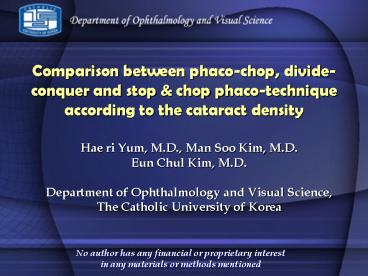Comparison between phaco-chop, divide-conquer and stop - PowerPoint PPT Presentation
Title:
Comparison between phaco-chop, divide-conquer and stop
Description:
Department of Ophthalmology and Visual ... Purpose To compare the intraoperative and short-term postoperative outcomes ... Results Endothelial cell count loss ... – PowerPoint PPT presentation
Number of Views:106
Avg rating:3.0/5.0
Title: Comparison between phaco-chop, divide-conquer and stop
1
Comparison between phaco-chop, divide-conquer and
stop chop phaco-technique according to the
cataract density
- Hae ri Yum, M.D., Man Soo Kim, M.D.
- Eun Chul Kim, M.D.
- Department of Ophthalmology and Visual Science,
- The Catholic University of Korea
No author has any financial or proprietary
interest in any materials or methods mentioned
2
Introduction
- Phacoemulsification was the technique that was
- performed in almost all cataract surgery.
- When phacoemulsification was first introduced,
- the nucleus was not divided and the phaco-
- emulsification probe was used to sculpt and
- consume the nucleus.
- Compared with extracapsular cataract extraction,
- phacoemulsification in associated with
additional - potential risks of corneal endothelial cell
damage.
3
Purpose
- To compare the intraoperative and short-term
postoperative outcomes of cataract surgery
performed with 3 different types of the
phaco-technique (phaco-chop, divide-conquer and
stop chop) under microcoaxial or conventional
cataract surgery according to the cataract
density.
4
Materials Methods
90 cataract eyes with nuclear density from Grade
2 to 4
Cataract density (NO2 ,NO3, NO4)
Phaco-Chop
Divide-Conquer
Stop Chop
5
Materials Methods
- Intraoperative measurements
- Effective phacoemulsification time (EPT)
- Mean cumulative dissipated ultrasound energy
(CDE) - Total balanced salt solution (BSS) use
- Clinical measurements
- Preoperative, 1-day postoperative, 1,2-month
postoperative - Best corrected visual acuity (BCVA)
- Central corneal thickness
- Endothelial cell count
6
Results
ltBaseline preoperative clinical datagt
Group 1 (Phaco-Chop) (n30) Group 1 (Phaco-Chop) (n30) Group 1 (Phaco-Chop) (n30) Group 2 (Divide-Conquer) (n30) Group 2 (Divide-Conquer) (n30) Group 2 (Divide-Conquer) (n30) Group 3 (Stop Chop) (n30) Group 3 (Stop Chop) (n30) Group 3 (Stop Chop) (n30)
NO2 NO3 NO4 NO2 NO3 NO4 NO2 NO3 NO4
Mean age (y) 62.17.0 69.46.8 72.67.3 61.38.3 67.310.2 70.97.9 67.79.2 69.89.3 68.216.0
Preoperative visual acuity (lod MAR) 0.390.33 0.270.05 0.240.14 0.280.14 0.300.14 0.220.11 0.260.22 0.340.16 0.190.18
Preoperative corneal thickness (µm) 51718.5 52611.0 5269.0 52215.6 52212.4 52312.5 51911.6 52015.8 52312.4
Preoperative endothelial cell count 2655333 2632315 2460336 2744405 2330543 2633303 2319278 2697304 2480367
? No significant difference between groups
7
Results
ltintra-op./EPT, CDE, BSS usegt
The phaco-chop technique can provide more
effective lens removal than divide-conquer and
stop chop phaco technique with lower
phacoemulsification time and energy in the mature
cataract.
EPT effective phacoemulsification time CDE mean
cumulative dissipated ultrasound energy BSS
balanced salt solution
8
Results
Endothelial cell count loss rate ()
Nuclear opacity
Tukey HSD and Duncan test
Although the mean endothelial cell loss was less
in phaco-chop groups than those in divide-conquer
and stop chop groups , the difference between
groups was not significant statistically.
9
Results
CCT change ()
Nuclear opacity
Tukey HSD and Duncan test
CCT central corneal thickness (µm)
Although the central corneal thickness increased
after phacoemulsification , there was less change
in phaco-chop than divide-conquer and stop chop
, the difference was not significant.
10
Results
ltBCVA (best corrected visual acuity)gt
Group 1 (Phaco-Chop) (n30) Group 1 (Phaco-Chop) (n30) Group 1 (Phaco-Chop) (n30) Group 2 (Divide-Conquer) (n30) Group 2 (Divide-Conquer) (n30) Group 2 (Divide-Conquer) (n30) Group 3 (Stop Chop) (n30) Group 3 (Stop Chop) (n30) Group 3 (Stop Chop) (n30)
NO2 NO3 NO4 NO2 NO3 NO4 NO2 NO3 NO4
Pre op. 0.390.33 0.270.05 0.240.14 0.280.14 0.300.14 0.230.11 0.260.22 0.340.16 0.190.18
1 day 0.850.18 0.750.16 0.750.16 0.750.28 0.770.19 0.700.25 0.710.29 0.660.21 0.630.17
1 month 0.870.16 0.780.12 0.770.14 0.770.26 0.780.18 0.720.22 0.810.18 0.730.15 0.780.18
2 month 0.910.10 0.870.11 0.850.09 0.850.14 0.870.08 0.850.14 0.870.12 0.880.10 0.860.12
? No significant difference between groups
11
Conclusion
- The phaco-chop technique can provide more
effective lens removal than divide-conquer with
lower phacoemulsification time and energy in the
mature cataract. - However, the phaco-chop, divide-conquer and stop
chop technique may be all effective for both of
microcoaxial and conventional incision cataract
surgery. - There is an advantage of phaco-chop over
divide-conquer and stop chop in both CCT and
ECC change but this advantage is no significant
difference statistically.































